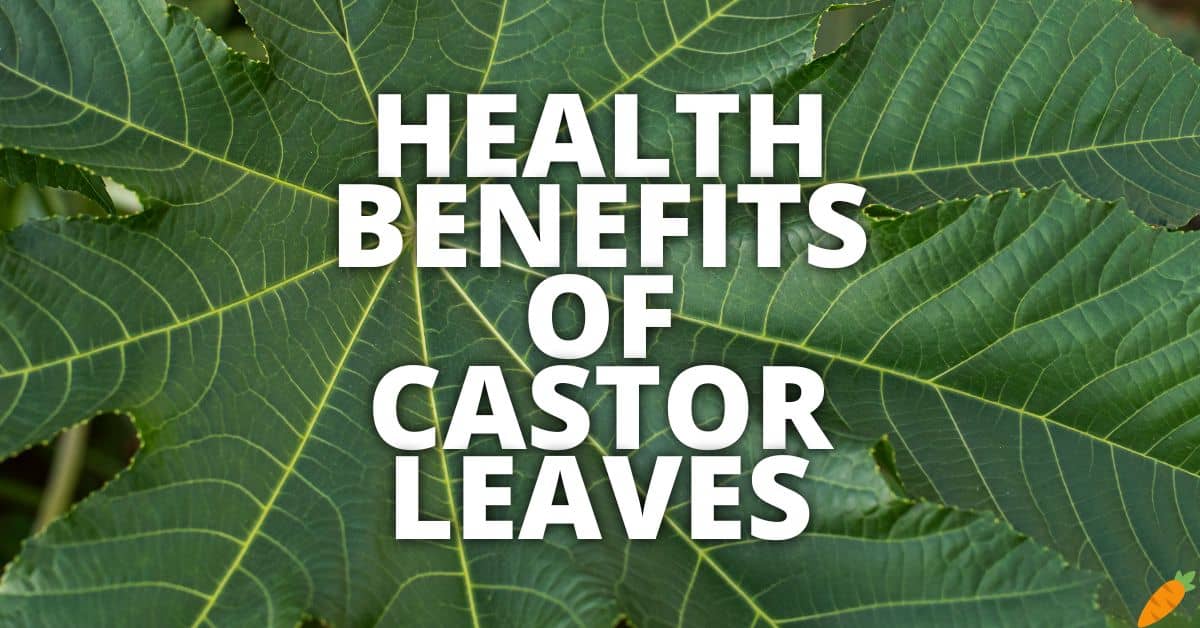It’s a marvelous day to explore the potential health benefits of castor leaves.
What are castor leaves?
Castor leaves belong to the Ricinus communis, or castor oil plant, native to the Mediterranean region, Eastern Africa, and India.
They are large and palmate, meaning they have several segments radiating from a central point.
The leaves typically have a deep green color, although some can be reddish or purplish.
The plant’s seeds are used to produce castor oil, a product with medicinal uses.
However, caution is required as the raw seeds are highly toxic due to the presence of the poison ricin.
Here’s a list of the potential health benefits of castor leaves:
- Alleviation Of Discomfort
- Reduction Of Inflammation
- Healing Of Wounds
- Treatment Of Fungal Conditions
- Arthritis And Joint Discomfort Management
- Abdominal Discomfort Remediation
- Mitigation Of Headache Symptoms
- Promotion Of Skin Well-Being
- Relief For Menstrual Cramps
- Improvement Of Lymphatic Function
- Soothing Mastitis Symptoms
If you want to learn more, please keep reading.
1. Pain Relief
Castor leaves, when used as a topical application, may offer pain relief for minor aches and discomforts.
In traditional medicine, the leaves are often heated slightly and applied to the affected area.
This is based on the belief that the plant has analgesic properties that can soothe localized pain.
They have been used for ailments ranging from muscle sprains to mild joint aches.
However, it’s important to note that these claims are largely anecdotal, and further scientific research is needed to substantiate them.
2. Anti-Inflammatory Properties (My Favorite Potential Health Benefit Of Castor Leaves)
Castor leaves are traditionally believed to possess anti-inflammatory properties, which can help reduce inflammation when applied to the skin.
The leaves are typically prepared as a poultice or used in compresses and applied to the inflamed area.
This is thought to soothe inflammation caused by conditions like arthritis, sprains, or skin irritations.
Despite these traditional uses, it should be noted that the scientific evidence supporting the anti-inflammatory benefits of castor leaves specifically is limited.
Therefore, these uses should be approached with caution until more research is conducted.
3. Wound Healing
Castor leaves are traditionally believed to help with wound healing when applied topically.
This application may accelerate the healing process and reduce the chance of infection due to its potential antibacterial properties.
In traditional medicine, a poultice of the leaves is often used directly on minor cuts, burns, or abrasions.
However, it’s important to note that the direct evidence of castor leaves aiding wound healing is largely anecdotal and lacks comprehensive scientific research.
Always consult a healthcare professional for severe or non-healing wounds.
4. Fungal Infections
Castor leaves have been traditionally used to potentially treat fungal infections, particularly on the skin.
The leaves may possess antifungal properties that could help fight off certain fungal pathogens when applied topically.
Traditional medicine frequently applies a paste or poultice made from the leaves to the area where the fungal infection is present.
However, scientific evidence to support these antifungal properties is still lacking, and much of this knowledge is based on traditional use and anecdotal evidence.
Therefore, it’s recommended to consult a healthcare provider for appropriate treatments for fungal infections.
📚 Multifarious Uses Of Castor (Ricinus Communis L.)
5. Joint Pain And Arthritis
The application of heated castor leaves to joints for arthritis relief is a practice found in traditional medicine.
The warmth from the leaves, combined with purported anti-inflammatory properties, may help reduce joint swelling and pain associated with arthritis.
This practice usually involves heating the leaves, applying them to the affected area, and covering them with a cloth to maintain the heat.
Despite this traditional usage, concrete scientific evidence supporting this practice is lacking.
Therefore, it’s important to consult with a healthcare provider when considering alternative treatments for arthritis.
📙 Cashew Leaves might also help with joint pain and arthritis. On this page, you can learn more about how it can help your health.
6. Abdominal Issues
In traditional medicine, castor leaves have been used in compresses to potentially alleviate abdominal discomfort.
This practice involves applying a compress made from heated castor leaves to the abdomen, believed to soothe issues like indigestion, bloating, or menstrual cramps.
The warmth and the purported analgesic properties of the leaves may provide some temporary relief.
However, it’s important to remember that this use is largely based on tradition and anecdotal evidence.
For persistent or severe abdominal discomfort, it is crucial to seek advice from a healthcare professional.
7. Headache Relief
Traditional practices often involve the use of castor leaves for potential relief from headaches.
In this method, a cloth soaked in warm castor oil or a heated castor leaf is applied to the forehead, which is believed to help alleviate the pain and tension associated with a headache.
The warmth from the leaf or oil may also provide a soothing effect.
However, the effectiveness of this remedy is largely based on traditional use and anecdotal reports.
As with any health issue, it’s recommended to consult with a healthcare provider for persistent or severe headaches.
8. Skin Health
Due to the widespread belief in the nourishing and healing properties of castor leaf extracts, some people have used them for skincare.
These extracts, often incorporated into creams or oils, may help moisturize the skin, reduce inflammation, and potentially aid in the healing of minor skin issues.
The leaves may contain antioxidants, which are generally beneficial for skin health.
However, the use of castor leaf extracts for skincare is largely based on anecdotal evidence and traditional use.
It’s important to conduct a patch test before applying new products to the skin and consult a dermatologist for severe skin issues.
9. Menstrual Cramp Relief
Castor leaves have been used traditionally to alleviate menstrual cramps when applied to the lower abdomen.
This involves placing heated castor leaves on the abdomen, which is thought to help reduce pain and discomfort associated with menstrual cramps due to the warmth and potential analgesic properties of the leaves.
The method is based on traditional practices and anecdotal evidence.
However, it’s important to remember that scientific research is lacking in this area, and for severe or persistent menstrual cramps, it’s advisable to consult with a healthcare provider for appropriate treatments.
📚 Pharmacognostical Evaluation Of Castor Leaves
10. Lymphatic Health
Some natural health practitioners recommend the use of castor leaf packs to stimulate the lymphatic system, which is vital for immune function.
This practice often involves applying a cloth soaked in castor oil or heated castor leaves to the skin in the belief that it may promote lymphatic circulation and detoxification.
The theory suggests that this may aid in removing waste and toxins from the body.
Despite these practices, scientific evidence supporting the use of castor leaf packs for lymphatic health is currently limited.
As with any health practice, it’s important to consult a healthcare provider for personalized advice.
📙 Ozonated olive oil may also be beneficial to lymphatic health. Learn more about how it can benefit your health on this page.
11. Mastitis Relief
In traditional medicine, castor leaves have been used as a home remedy to alleviate the inflammation and pain associated with mastitis, a breast tissue infection.
This often involves applying heated castor leaves directly to the affected area to supposedly draw out the infection and reduce swelling and discomfort.
The warmth, combined with the purported anti-inflammatory properties of the leaves, may provide some relief.
Mastitis is a serious condition that requires professional management, but these practices are largely based on anecdotal evidence.
Always consult a healthcare provider for appropriate treatment options for mastitis.
💡 Conclusion
Castor leaves, part of the Ricinus communis, or castor oil plant, have been used traditionally for a variety of health purposes.
They have been touted for their potential to relieve pain, reduce inflammation, promote wound healing, and even aid in skin health, among other benefits.
However, it’s important to underline that much of the knowledge about these potential health benefits is based on traditional practices and anecdotal evidence, with scientific research still lagging behind.
While these leaves might offer certain benefits, they must be used with caution due to the presence of the toxic compound ricin in the raw seeds of the plant.
As always, it’s advisable to consult a healthcare provider before starting any new health regimen or treatment.
With more research, the full spectrum of benefits of castor leaves could be better understood and harnessed.
Until then, they will remain a fascinating part of traditional medicine practices worldwide.
😊 My favorite potential health benefits of castor leaves are that they may have anti-inflammatory properties and that they may help with joint pain and arthritis.
These are exactly why I started this blog.
When I was a little kid, my grandparents also used leaves to relieve different health conditions.
Just like how castor leaves are heated, they do the same.
I remember that during the first instances of my arthritis, either my grandfather or grandmother would use heated leaves as patches on my joints.
I just can’t remember what the names of the leaves were.
What’s your favorite potential health benefit of castor leaves?
I’ve also written articles about different plants that may have potential health benefits.
Please share this article with your family and friends if you find it useful.
I appreciate it!
Stay healthy and safe!
⛑️ Safety First
While castor leaves have been traditionally used for various health benefits, it’s crucial to take precautions due to the potential toxicity of other parts of the plant, particularly the raw seeds.
People with plant allergies, pregnant or breastfeeding women, and individuals with specific medical conditions should refrain from using castor leaves without medical consultation.
It’s highly recommended to talk first with a healthcare provider before starting any new health regimen involving castor leaves.
These are potential health benefits, and some may be based on anecdotal evidence rather than rigorous scientific research.
Therefore, doing thorough research and seeking advice from professionals is of the utmost importance.
Remember, your safety and well-being should always come first.
📋 Summary
| Potential Health Benefits | Details |
| Pain Relief | Used topically to possibly alleviate minor aches and pains |
| Anti-Inflammatory | Applied to the skin to potentially reduce inflammation |
| Wound Healing | Applied topically to potentially aid in wound healing |
| Fungal Infections | Used to potentially treat certain skin infections due to purported antifungal properties |
| Joint Pain and Arthritis | Heated leaves applied to joints for potential arthritis relief |
| Abdominal Issues | Used in compresses to possibly alleviate abdominal discomfort |
| Headache Relief | Applied to the forehead to potentially alleviate headache symptoms |
| Skin Health | Used in skincare for its supposed nourishing properties |
| Menstrual Cramp Relief | Applied to the lower abdomen to potentially alleviate menstrual cramps |
| Lymphatic Health | Used in leaf packs to potentially stimulate the lymphatic system |
| Mastitis Relief | Used to potentially reduce inflammation and pain associated with mastitis |

